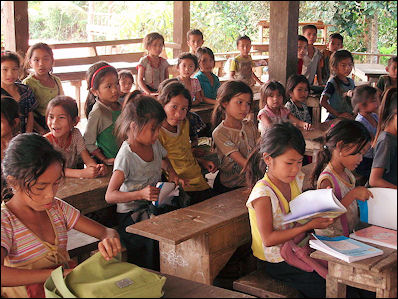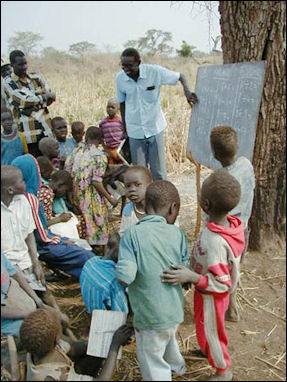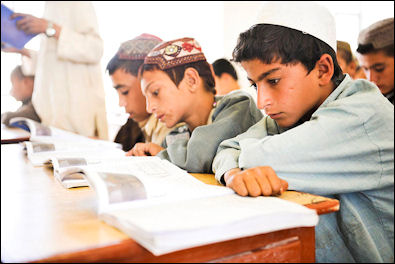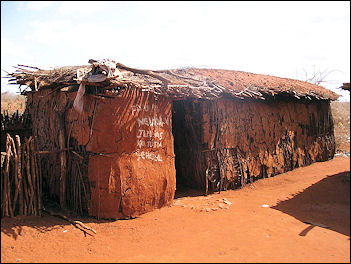SCHOOLS IN THE DEVELOPING WORLD

Primary school in Laos In most countries education is compulsory for six years, for children from age six to eleven. Primary schools have six grades; middle schools have three grades; and high schools have three grades. Most villages have primary schools. Older students generally have to travel a considerable distant from the their home villages to a middle school of high school.
In many places, children only attend primary school if they attend school at all and often stop going after three or four years. Some rural schools do not extend past the third grade. It is not unusual for a district with thousands of school age children to have fewer than a hundred actually in the local school, with only a handful finishing the six grades.
In many rural areas if someone has a middle school education they are regarded as wise and educated. Many villages have a village scribe that writes letters or does government paperwork for a small fee for people who are illiterate.
Staff-related spending accounts for between 50 percent to 90 percent of annual budgets for health and education in the developing world.
Very few people get a university education and than those do tend to be the best and brightest or members of the elite. Unless they have connections those who graduate from university often can't find work or find the work that is available is so low paying that driving a taxi is more lucrative. Many university graduates leave the country or want to leave the country to seek a better life.
Schools in the Developing World
The schools in the cities are often better than the ones in the countryside. They have an easier time getting government money, teachers and books. The children generally come from families that are better off than there rural counterparts, and money they pay for school expenses helps make the schools better.
Many schools were set up by missionary groups. Missionary schools often provide the best education. In the cities the elite attend elite private, religious of international schools.
Many rural schools are nothing more than cement block, thatch or mud buildings, about the size of a large suburban garage or small warehouse, with four or five rooms. There are generally have no windows, doors, or electricity, and few academic and athletic facilities other than a chalkboard, maybe some desks and chairs and courtyard where children play rough games. Schools are considered well equipped if they have a dirt soccer field.
The curriculum is often patriotic and is designed to serve the needs of the ruling regime more than it is to educate students. Textbooks are in short supply and have been so heavily used the paper is cracking and transparent with age. Paper, pens and pencils are also in short supply and children often write on slates with broken pieces of chalk.
Many villages build their own schools and then ask the government for a teacher. Classes are often taught in local languages which are little value in the major cities where most of the jobsare and other languages predominate.
School Expenses, a Better Life and Why Children Don't Attend School

Village school in Northern Bahr
el Ghazal Sudan Like parents around the world, poor villagers want their children to succeed in school, but the obstacles just to get them enrolled are enormous. Even though schools are free, the books and clothes required to attend are so expensive they can eat up as much a third of the villager's income.
A family that grows a cash crop such as coffee may bring in US$120 a year after expenses for fertilizer and pesticides while schools charge $75 a year per student for uniforms and books. Since most families average between four and eight children, even with father working odd jobs, there is usually only enough money to send two or three children to school at the most.
Rural families often make great sacrifices to send their children to school. The children in turn feel a lot of pressure to perform well, get good jobs and provide for the parents and relatives that made so many sacrifices for them.
In many cases, children go to school and learn to read but fail to improve there lives. Even students that are bright and privileged to attend university find there are no jobs waiting for them when they graduate unless they have connections.
Although even the poorest families consider education to be of utmost importance, many families can't send their children to school because schools are in short supply, too expensive or too far away and children are needed to do chores or make money.
Despite compulsory education laws, many children are often at home working in the fields or taking care of other children or in the streets, shops or factories, earning some money. Even bright kids drop out because their families needed money immediately and promises offered ten years down the line by a university education seem remote.
Students and Secondary Education in the Developing World
Children from a wide range of ages and abilities often attend the same class. Bright students are often selected by the family to go to school while slow learners have to stay home and help with chores around the house. In rural areas, many children have to walk several miles to their schools.
Middle schools and high schools are often located in towns far away from villages. Students that want to attend them have move from their family homes, live in dormitory and visit their families only on the weekends. To avoid breaking up their families, the goal of many village parents is to earn enough money or get a new job so they move to a large town or city where there children can receive a secondary education.
Secondary school students are required to wear uniforms. The boys dress in jackets and ties and the girls have on sweaters and plaid skirts. The class sizes are big but the students are surprisingly well behaved because they are happy just to be getting an education. Classes often begin with the students standing up and saying hello to the teacher and then sitting down.
Teachers, School Days, Discipline, Grades and Bribes

Afghan school for boys Teachers are usually exhausted by the overcrowded classes and insufficient facilities. They are often absent and when they are in school often little instruction is done. It is not unusual to see teachers sitting around veranda passing time, while the children are playing and looking after themselves.
School often begins around 7:30 with a flag raising ceremony and a lecture from the principal who speaks through a bullhorn. Children study mathematics, reading, writing and propaganda. During recess they do calisthenics and relaxation exercises.
The classes are often very large?often 50 or more students. To keep order children are sometimes painfully disciplined in front of an assembly of students. It is not unusual for principals and teachers to strike students with sticks or fists, pull on their ears, and make them stand for long periods of time with their arms or legs raised.
Bribery is very common in the schools. The parents of failing students often make teachers very generous offers or give them nice gifts on the Teachers Day holiday. The going rate for a "pass" may be the equivalent of about $100 while and "A" goes for as much as $500.
In an attempt to crack down on such practice, governments do things like hand out special grade books to teachers that have to be filled out with permanent ink. If a teacher makes a mistake?wrote down a "C" instead of "B" for example?the entire grade book had to be scraped and a new one filled out.
Teacher Absenteeism in Village Schools
One of the biggest problems with education and health care in the developing world, according to the World Bank, is not a lack of money but “getting teachers and doctors to report to work.” When Harvard and World Bank researchers conducted unannounced visits to primary schools in rural India they found a quarter of the teachers absent and only half of those present were actually working. Similar research in Indonesia found a fifth of the teachers absent. The study also covered Peru, Ecuador and Uganda.

School in a Maasai village in Kenya Lack of infrastructure is a serious problem at many schools in developing countries and one that is linked to teacher absenteeism. Many schools don’t have toilets and have their electricity cut off because their power bills have not been paid by the Education Ministry. A 2004 study in Indonesia found that teachers were 11 percent more likely to show up for work if their schools had a toilet.
Another reason for high teacher absenteeism is the state use of teachers to perform duties required by the state that don’t have anything to do with teaching such as working at elections and overseeing polio vaccination campaigns, as is the case in India. At some schools in India that offered school lunch programs to attract students, teachers were spending more time cooking than teaching.
The Harvard and World Bank study suggests that paying higher salaries is not the solution. In Bangladesh it found the highest rates of absenteeism among headmasters was among those who were the highest paid.
One solution the Harvard and World Bank study suggested was experimenting with systems in which parents were allowed to chose schools for their children and public money would go to those schools. The system could both work within the public school system and incorporate private schools.
Education and Girls in the Developing World
Literacy rates for boys and men are generally higher than for girls and women. According to UNICEF, two thirds of the world’s illiterate people are women and girls.
Most girls that do attend school leave before they are teenagers. The decision to keep girls out of school is often made by fathers, who feel that boys are more likely to earn healthy incomes in the future and thus have a priority within families to get an education. Fathers also believe girls are more useful making money when they are young before they get married and leave the family.
Girls often can't go to school because they have to stay home to perform chores or take care of their younger siblings. Without school, young girls are condemned to a life of illiteracy and limited skills. This keeps society as a whole from developing and impedes the tackling of problems like population growth and infant and child mortality.
A higher percentage of students in rural schools are girls than years before. But they are still significantly outnumbered by boys. Educated girls marry later, have fewer children and are more likely to seek medical attention sooner. A skill as basic as sewing can help a girl get ahead in the future.
According to UNICEF 90 million girls worldwide are being excluded from primary school, primarily because of outdated female stereotypes and early pressure to get married. By contrast about 25 million boys are not receiving primary education.
$100 Laptop

One Laptop per Child at
Kagugu Primary School in Kigali, Rwanda In 2007 the “One Laptop per Child? program of the Media Lab of Massachusetts Institute Technology unveiled their $100 laptop. It initially cost about $188 per unit but the cost was expected to come down to $100 per unit when production reached the 50 million mark.
The main force behind the project was Nicholas Negroponte, the former head of MIT’s Media Lab. His hope was to put computers in the hands of millions of schoolchildren in the developing world. Endorsed by the United Nations and unveiled at the 2006 World Economic Forum in Davos, the devise is about the size of a textbook, has wireless capabilities and can operate in places without electricity. Critics dismiss it as a “gadget? not a computer and say it has a limited range of programs and capabilities.
The “$100 laptops" are lime green and white and constructed for a child to use. They have a keyboard that can be switched to different languages, a digital video camera, wireless connectivity to a variety of systems, and Linux open-source operating software tailored for remote regions. The computer also comes with a stripped-down browser, simple world processor, a number of learning programs and Google’s g-mail e-mail service.
See Separate Article COMMUNICATIONS, COMPUTERS AND CELL PHONES IN THE DEVELOPING WORLD factsanddetails.com
Image Sources: Wikimedia Commons
Text Sources: New York Times, Washington Post, Los Angeles Times, Times of London, Yomiuri Shimbun, The Guardian, National Geographic, The New Yorker, Time, Newsweek, Reuters, AP, Lonely Planet Guides, Compton’s Encyclopedia and various books and other publications.
Last updated January 2012
